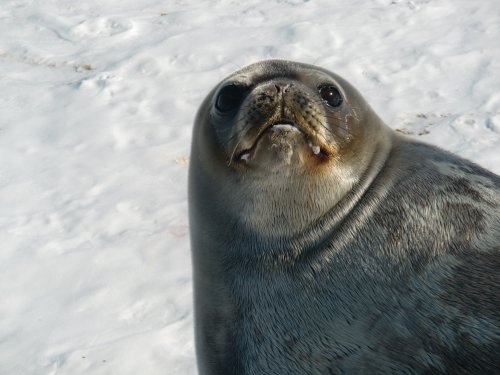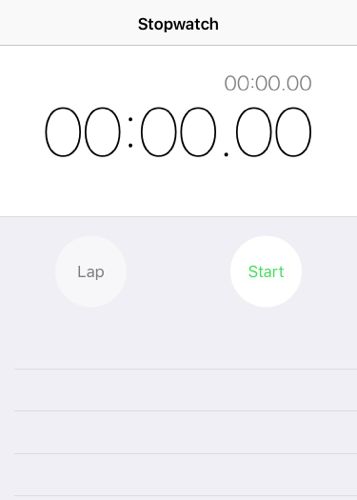Like humans, Weddell seals are mammals. One important characteristic of mammals is breathing air. And, you need to have lungs to do that. But how do their lungs work?
 See this seal coming up for a breath? Let’s find out where the air goes inside its body! Photo credit: Alex Eilers, MMPA Permit # 17411
See this seal coming up for a breath? Let’s find out where the air goes inside its body! Photo credit: Alex Eilers, MMPA Permit # 17411
How do lungs work?
Let’s take human lungs as an example. Humans inhale air, which contains oxygen, through their nose or mouth. That air fills their lungs, which are made of tissue that can easily expand and contract. The oxygen then diffuses (spreads/moves) from the air in the lungs to the blood. There, it is stored by a protein called hemoglobin and circulated through the body. All cells in your body need oxygen, and it’s the job of hemoglobin to make sure they get it. Your cells take the oxygen, use it when they produce energy, and produce carbon dioxide as waste. The carbon dioxide is then carried by the blood to the lungs. The lungs then get rid of this carbon dioxide when you exhale.
Pretty cool, right?
What’s different about Weddell lungs?
If you pressed on your chest, would your chest cavity get smaller? Go ahead, try it! Didn’t move, right? And that’s a good thing! Your ribs are very strong and rigid and are there to protect your lungs and other internal organs. Unlike us, Weddell seals have very flexible chest cavities. So flexible, that they can actually make their chest cavities smaller! Why do you think they would need to do this?
Any guesses?
 How do seals stay under water for so long? It all has to do with the lung. Photo credit: Alex Eilers, MMPA Permit # 17411
How do seals stay under water for so long? It all has to do with the lung. Photo credit: Alex Eilers, MMPA Permit # 17411
How does this work?
It’s because of water pressure. The further you go under water, the greater the water pressure. Have you ever gone down to the deep end of a pool? How did you feel? Your ears might have popped or your head might have started to hurt. The water pressure was pushing on your air spaces (like your sinuses) and causing them to contract, which can be painful. Humans are definitely not designed to be deep divers! But Weddell seals are, and here’s how they do it!
As a seal dives and the pressure of the water increases, the volume of air in the seal’s lungs gets smaller and the seal’s chest cavity collapses. They also don’t have any of the extra air spaces that humans have, so their ears won’t pop and their head won’t hurt.
 Diagram of a seal’s lung, both the alveolar sac and the lobule collapse when the seal dives. Photo credit: Meredith Olinger
Diagram of a seal’s lung, both the alveolar sac and the lobule collapse when the seal dives. Photo credit: Meredith Olinger
At the base of Weddell seal lungs (and in all lungs) are tiny little air sacs called alveoli. This is the area of the lung where gas moves between the lung and the blood. The tissue is very thin in this area of the lung. When the seal dives, the volume of air in the aveoli decreases due to pressure, and the aveoli collapses just like a little balloon. But don’t worry, it won’t stay collapsed forever. When the seal surfaces and takes a breath, the alveoli re-inflate. The alveoli don’t stick closed because they are coated with a layer of surfactant which is a slippery fluid. Sometimes, after a dive, seals will cough up extra surfactant – when I saw the seal cough up the white, soapy substance, I thought she had a cold!
Did you know, we have surfactant too; seals just produce much more of it than we do.
 Do you see the foamy surfactant around this seal’s mouth? Photo credit: Alex Eilers, MMPA Permit # 17411
Do you see the foamy surfactant around this seal’s mouth? Photo credit: Alex Eilers, MMPA Permit # 17411
Weddell seals are unique. When they are about to dive, they exhale most of the air out of their lungs. What do you do before you jump in a pool? You probably take a big breath and hold it. Weddell seals do the opposite! This helps their chest cavity collapse more quickly. It also helps them dive deeper. Air floats, so exhaling as much as possible will allow them to dive deeper and more quickly.
How long can Weddell seals stay under water?
How long can you hold your breath? Go ahead and try it… I’ll wait!
 How long can you hold your breath?
How long can you hold your breath?
How long can you hold your breath?
If you were like me, probably not very long! I make it about 46 seconds before I start gasping for air! How about 96 minutes? That’s the longest Weddell seal dive ever recorded. A typical dive for a Weddell, however, is about 20 minutes. That’s still a really long time! Longer dives are generally to escape predators or to explore new territory.
Diving Deeper: gases, air pressure & Boyle’s Law
Let’s talk a little bit more about the collapsing of Weddell seal lungs. We know that these seals exhale a lot of air before they dive, but they don’t exhale all of the air in their lungs. When the lungs collapse, where does the air inside of them go?
The air doesn’t just disappear! One of the things that make gases so cool is that they can take the shape of whatever container they are in. As the seal dives, water pressure increases. It’s this increased pressure that decreases the volume of air in the lungs. So, to prevent a mismatch in pressure, both inside and surrounding the seal, the seals chest cavity changes or compresses in response to the increased pressure.
Remarkable, isn’t it!
Air itself, however, doesn’t get ‘smaller’. The molecules stay the same size; they just don’t have as much space to move around. With this decrease in space, the air molecules start to bump into each other more. This confinment causes an increase in air pressure inside the lungs. There’s a rule in science that says if you have a certain volume of gas and you decrease the amount of space that gas can fill without changing the temperature – the pressure increases. That’s Boyle’s Law.
 Boyle’s Law: when volume decreases, pressure increase. Photo credit: Meredith Olinger
Boyle’s Law: when volume decreases, pressure increase. Photo credit: Meredith Olinger
The equation for Boyle’s Law is: PV=k
In the equation, ‘P’ stands for pressure and ‘V’ stands for volume. K is a constant.
Boyle’s Law applies to seal lungs, your lungs, balloons, car tires or anything that involves gas changing volume or pressure. See where you notice Boyle’s Law in action today!


Comments